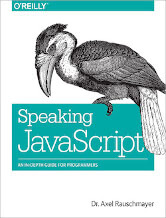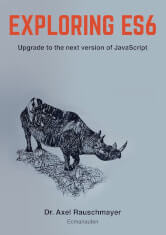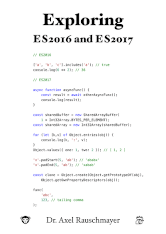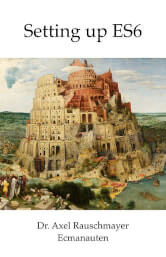Last Updated on November 22, 2025
4. Speaking JavaScript by Axel Rauschmayer

Like it or not, JavaScript is everywhere these days—from browser to server to mobile—and now you, too, need to learn the language or dive deeper than you have. This concise book guides you into and through JavaScript, written by a veteran programmer who once found himself in the same position.
Speaking JavaScript has been written for programmers, by a programmer.
In order to understand the book, you should already know object-oriented programming, for example, via a mainstream programming language such as Java, PHP, C++, Python, Ruby, Objective-C, Swift, C#, or Perl.
Speaking JavaScript has four parts:
- JavaScript Quick Start: Learn a safe subset of JavaScript in less than 30 pages.
- Background: When, why, and how was JavaScript created? How is it related to other programming languages? What were the important steps that got us to where we are today?
- JavaScript in Depth: This part is more of a reference: look for a topic that you are interested in, jump in, and explore. I still tried to make it fun to read.
- Tips, Tools, and Libraries: This part gives tips for using JavaScript: best practices, advanced techniques, and learning resources. It also describes a few important tools and libraries.
This book covers JavaScript up to and including ECMAScript 5.
5. Exploring ES6
 Exploring ES6 is about ECMAScript 6 (whose official name is ECMAScript 2015). In order to understand this book, you should already know JavaScript.
Exploring ES6 is about ECMAScript 6 (whose official name is ECMAScript 2015). In order to understand this book, you should already know JavaScript.
This book covers ECMAScript 6 in depth, but is structured so that you can also quickly get an overview if you want to.
This book covers ES6 with three levels of detail:
- Quick start: Begin with the chapter “Core ES6 features”. Additionally, almost every chapter starts with a section giving an overview of what’s in the chapter. The last chapter collects all of these overview sections in a single location.
- Solid foundation: Each chapter always starts with the essentials and then increasingly goes into details. The headings should give you a good idea of when to stop reading, but I also occasionally give tips in sidebars w.r.t. how important it is to know something.
- In-depth knowledge: Read all of a chapter, including the in-depth parts.
6. Exploring ES2016 and ES2017
 This book is about two versions of JavaScript: ECMAScript 2016 and ECMAScript 2017
This book is about two versions of JavaScript: ECMAScript 2016 and ECMAScript 2017
ES6 was by far the biggest update to the language with Modules, Classes and much more.
The 2016 and 2017 iterations bring worthwhile improvements, such as: Async functions, Shared memory and atomics, as well as improvements to core Array and String classes.
7. Setting up ES6

Setting up ES6 explains how to configure Babel. It also covers setting up ES6 projects that are compiled to ES5 via Babel.
The book also explains deploying ES6 in browsers via Babel and webpack and deploying ES6 in Node.js, by statically or dynamically compiling it via Babel.
Chapters cover:
- Deploying ECMAScript 6 – describes the options you have for deploying ECMAScript 6 in current JavaScript environments. It is selective w.r.t. the amount of tools it covers.
- Babel setups for browsers and Node.js – covers example transpilation setups for Babel.
- Configuring Babel 6 – this chapter offers tips.
- Babel: configuring standard library and helpers – explains how to configure how Babel 6 accesses its own helper functions and the ES6 standard library.
- Babel’s loose mode – transpiles ES6 code to ES5 code that is less faithful to ES6 semantics. This chapter explains how that works and what the pros and cons are.
- Babel and CommonJS modules – examines how Babel ensures that code it transpiles interoperates properly with normal CommonJS modules.
- The future of bundling JavaScript modules – examines how the bundling of modules is affected by two future developments: HTTP/2 and native modules.
Pages in this article:
Page 1 – Understanding ECMAScript 6 and more books
Page 2 – Speaking JavaScript and more books
All books in this series:
| Free Programming Books | |
|---|---|
| Ada | ALGOL-like programming language, extended from Pascal and other languages |
| Agda | Dependently typed functional language based on intuitionistic Type Theory |
| Arduino | Inexpensive, flexible, open source microcontroller platform |
| Assembly | As close to writing machine code without writing in pure hexadecimal |
| Awk | Versatile language designed for pattern scanning and processing language |
| Bash | Shell and command language; popular both as a shell and a scripting language |
| BASIC | Beginner’s All-purpose Symbolic Instruction Code |
| C | General-purpose, procedural, portable, high-level language |
| C++ | General-purpose, portable, free-form, multi-paradigm language |
| C# | Combines the power and flexibility of C++ with the simplicity of Visual Basic |
| Clojure | Dialect of the Lisp programming language |
| ClojureScript | Compiler for Clojure that targets JavaScript |
| COBOL | Common Business-Oriented Language |
| CoffeeScript | Transcompiles into JavaScript inspired by Ruby, Python and Haskell |
| Coq | Dependently typed language similar to Agda, Idris, F* and others |
| Crystal | General-purpose, concurrent, multi-paradigm, object-oriented language |
| CSS | CSS (Cascading Style Sheets) specifies a web page’s appearance |
| D | General-purpose systems programming language with a C-like syntax |
| Dart | Client-optimized language for fast apps on multiple platforms |
| Dylan | Multi-paradigm language supporting functional and object-oriented coding |
| ECMAScript | Best known as the language embedded in web browsers |
| Eiffel | Object-oriented language designed by Bertrand Meyer |
| Elixir | Relatively new functional language running on the Erlang virtual machine |
| Erlang | General-purpose, concurrent, declarative, functional language |
| F# | Uses functional, imperative, and object-oriented programming methods |
| Factor | Dynamic stack-based programming language |
| Forth | Imperative stack-based programming language |
| Fortran | The first high-level language, using the first compiler |
| Go | Compiled, statically typed programming language |
| Groovy | Powerful, optionally typed and dynamic language |
| Haskell | Standardized, general-purpose, polymorphically, statically typed language |
| HTML | HyperText Markup Language |
| Icon | Wide variety of features for processing and presenting symbolic data |
| J | Array programming language based primarily on APL |
| Java | General-purpose, concurrent, class-based, object-oriented, high-level language |
| JavaScript | Interpreted, prototype-based, scripting language |
| Julia | High-level, high-performance language for technical computing |
| Kotlin | More modern version of Java |
| LabVIEW | Designed to enable domain experts to build power systems quickly |
| LaTeX | Professional document preparation system and document markup language |
| Lisp | Unique features - excellent to study programming constructs |
| Logo | Dialect of Lisp that features interactivity, modularity, extensibility |
| Lua | Designed as an embeddable scripting language |
| Markdown | Plain text formatting syntax designed to be easy-to-read and easy-to-write |
| Objective-C | Object-oriented language that adds Smalltalk-style messaging to C |
| OCaml | The main implementation of the Caml language |
| Pascal | Imperative and procedural language designed in the late 1960s |
| Perl | High-level, general-purpose, interpreted, scripting, dynamic language |
| PHP | PHP has been at the helm of the web for many years |
| PostScript | Interpreted, stack-based and Turing complete language |
| Prolog | A general purpose, declarative, logic programming language |
| PureScript | Small strongly, statically typed language compiling to JavaScript |
| Python | General-purpose, structured, powerful language |
| QML | Hierarchical declarative language for user interface layout - JSON-like syntax |
| R | De facto standard among statisticians and data analysts |
| Racket | General-purpose, object-oriented, multi-paradigm, functional language |
| Raku | Member of the Perl family of programming languages |
| Ruby | General purpose, scripting, structured, flexible, fully object-oriented language |
| Rust | Ideal for systems, embedded, and other performance critical code |
| Scala | Modern, object-functional, multi-paradigm, Java-based language |
| Scheme | A general-purpose, functional language descended from Lisp and Algol |
| Scratch | Visual programming language designed for 8-16 year-old children |
| SQL | Access and manipulate data held in a relational database management system |
| Standard ML | General-purpose functional language characterized as "Lisp with types" |
| Swift | Powerful and intuitive general-purpose programming language |
| Tcl | Dynamic language based on concepts of Lisp, C, and Unix shells |
| TeX | Markup and programming language - create professional quality typeset text |
| TypeScript | Strict syntactical superset of JavaScript adding optional static typing |
| Vala | Object-oriented language, syntactically similar to C# |
| VHDL | Hardware description language used in electronic design automation |
| VimL | Powerful scripting language of the Vim editor |
| XML | Rules for defining semantic tags describing structure ad meaning |
